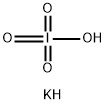Potassium periodate
Synonym(s):Periodic acid potassium salt;Potassium (meta)periodate;Potassium periodate
- CAS NO.:7790-21-8
- Empirical Formula: H2IKO4
- Molecular Weight: 232.01
- MDL number: MFCD00011407
- EINECS: 232-196-0
- SAFETY DATA SHEET (SDS)
- Update Date: 2024-12-18 14:08:57

What is Potassium periodate?
Chemical properties
colourless crystals or white crystalline powder
Physical properties
Colorless tetragonal crystals; density 3.618 g/cm3; melts at 582°C; slightly soluble in water at ordinary temperatures, 0.42 g/100mL at 20°C; moderately soluble in hot water, 4.4 g/100mL at 80°C.
The Uses of Potassium periodate
For the colorimetric determination of Mn (oxidizes manganese compounds to permanganates), as oxidizing agentPotassium periodate is used as an oxidizing agent in organic synthesis and an analytical reagent for the determination of potassium and cerium. It is also used in colorimetric estimation of manganese. It reacts with ammonium cerium(IV) nitrate to prepare tris[trinitratocerium(IV)] paraperiodate which finds application as an oxidant.
The Uses of Potassium periodate
Powerful oxidizer in acid solution, oxidizing manganese Compounds to permanganate; used for this purpose in analytical chemistry (colorimetric estimation of Mn), also for the oxidation of some organic Compounds.
What are the applications of Application
Potassium periodate is a useful oxidizing agent and laboratory reagent
Preparation
Potassium periodate can be prepared by oxidation of potassium iodate with a powerful oxidizing agent such as potassium permanganate, chlorine or bromine in basic solution:
IO3ˉ+ Cl2+ 2OHˉ→IO4ˉ+ 2Clˉ+ H2O
Also, the salt may be prepared by electrolysis.
Production Methods
Potassium periodate, KlO4, white solid, formed by electrolysis of potassium iodate under proper conditions.
General Description
Potassium (meta)periodate exhibits strong oxidizing properties in acidic medium.
Hazard
Fire risk in contact with organic materials, strong oxidizing agent. Strong irritant to tissue.
Purification Methods
Crystallise it from distilled water. Its solubility in H2O is 0.2% at 0o, 0.4% at 20o, 4.4% at 80o. and 7.9% at 100o. [Hill Inorg Synth I 171 1939, Schmeisser in Handbook of Preparative Inorganic Chemistry (Ed. Brauer) Academic Press Vol I p 325 1963.]
Properties of Potassium periodate
| Melting point: | 582 °C |
| Boiling point: | explodes [HAW93] |
| Density | 3.618 |
| vapor density | 7.9 (vs air) |
| storage temp. | 2-8°C |
| solubility | H2O: 0.01 M at 20 °C, clear, colorless |
| form | Powder/Solid |
| color | White to off-white |
| Specific Gravity | 3.618 |
| PH | pH (5g/l, 25℃) : 4.5~5.5 |
| PH Range | 4.5 - 5.5 |
| Odor | Odorless |
| Water Solubility | 0.42 g/100 mL (20 ºC) |
| Merck | 14,7654 |
| Stability: | Stable. Strong oxidizer - contact with combustible materials may cause fire. Incompatible with organic material, combustible material, strong reducing agents, powdered metals. |
| CAS DataBase Reference | 7790-21-8(CAS DataBase Reference) |
| EPA Substance Registry System | Periodic acid (HIO4), potassium salt (7790-21-8) |
Safety information for Potassium periodate
| Signal word | Danger |
| Pictogram(s) |
 Flame Over Circle Oxidizers GHS03  Corrosion Corrosives GHS05  Health Hazard GHS08  Environment GHS09 |
| GHS Hazard Statements |
H271:Oxidising liquids;Oxidising solids H314:Skin corrosion/irritation H372:Specific target organ toxicity, repeated exposure H400:Hazardous to the aquatic environment, acute hazard |
| Precautionary Statement Codes |
P210:Keep away from heat/sparks/open flames/hot surfaces. — No smoking. P260:Do not breathe dust/fume/gas/mist/vapours/spray. P273:Avoid release to the environment. P280:Wear protective gloves/protective clothing/eye protection/face protection. P303+P361+P353:IF ON SKIN (or hair): Remove/Take off Immediately all contaminated clothing. Rinse SKIN with water/shower. P305+P351+P338:IF IN EYES: Rinse cautiously with water for several minutes. Remove contact lenses, if present and easy to do. Continuerinsing. |
Computed Descriptors for Potassium periodate
Potassium periodate manufacturer
Prachi Pharmaceuticals Pvt Ltd
Ritesh Chemical Industries
DNS Fine Chemicals and Laboratories (P) Ltd
New Products
(S)-3-Aminobutanenitrile hydrochloride 4-Methylphenylacetic acid N-Boc-D-alaninol N-BOC-D/L-ALANINOL Tert-butyl bis(2-chloroethyl)carbamate N-octanoyl benzotriazole 3-Morpholino-1-(4-nitrophenyl)-5,6-dihydropyridin- 2(1H)-one Furan-2,5-Dicarboxylic Acid S-2-CHLORO PROPIONIC ACID ETHYL ISOCYANOACETATE 2-Bromo-1,3-Bis(Dimethylamino)Trimethinium Hexafluorophosphate 4-IODO BENZOIC ACID 3-NITRO-2-METHYL ANILINE 1-(2,4-DICHLOROPHENYL) ETHANAMINE (2-Hydroxyphenyl)acetonitrile 4-Bromopyrazole 5,6-Dimethoxyindanone 2-(Cyanocyclohexyl)acetic acid 4-methoxy-3,5-dinitropyridine 1-(4-(aminomethyl)benzyl)urea hydrochloride 2-aminopropyl benzoate hydrochloride diethyl 2-(2-((tertbutoxycarbonyl)amino) ethyl)malonate tert-butyl 4- (ureidomethyl)benzylcarbamate Ethyl-2-chloro((4-methoxyphenyl)hydrazono)acetateRelated products of tetrahydrofuran








You may like
-
 Potassium periodate, For ACS analysis CAS 7790-21-8View Details
Potassium periodate, For ACS analysis CAS 7790-21-8View Details
7790-21-8 -
 Potassium periodate, For ACS analysis CAS 7790-21-8View Details
Potassium periodate, For ACS analysis CAS 7790-21-8View Details
7790-21-8 -
 Potassium Periodate extrapure AR CAS 7790-21-8View Details
Potassium Periodate extrapure AR CAS 7790-21-8View Details
7790-21-8 -
 Potassium periodate 99.00% CAS 7790-21-8View Details
Potassium periodate 99.00% CAS 7790-21-8View Details
7790-21-8 -
 Potassium periodate CAS 7790-21-8View Details
Potassium periodate CAS 7790-21-8View Details
7790-21-8 -
 Potassium periodate, GR 99%+ CAS 7790-21-8View Details
Potassium periodate, GR 99%+ CAS 7790-21-8View Details
7790-21-8 -
 Potassium Metaperiodate CAS 7790-21-8View Details
Potassium Metaperiodate CAS 7790-21-8View Details
7790-21-8 -
 Potassium Metaperiodate CAS 7790-21-8View Details
Potassium Metaperiodate CAS 7790-21-8View Details
7790-21-8